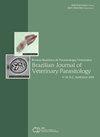大角角蛾乳胶的化学成分及对弯血螨的超微结构影响
IF 1.2
4区 农林科学
Q4 PARASITOLOGY
引用次数: 11
摘要
摘要本研究旨在探讨大角角蛾乳剂对弯血螨的驱虫作用和超微结构作用。在10,000×g进行两次离心,透析得到富含蛋白质的部分,命名为LP(乳胶蛋白),在3000 rpm下得到富含次级代谢物的部分,命名为LNP(乳胶非蛋白)。采用扫描电镜(SEM)和透射电镜(TEM)观察在LNP、LP和PBS作用下的H. contortus成虫运动试验(AWMT)的超微结构变化。LNP中的植物化学测试表明存在酚类,类固醇,生物碱和核桃苷。高效液相色谱(HPLC)表征了LNP中未食子酸和槲皮素的存在。LP蛋白含量为43.1±1.1 mg/mL, LNP蛋白含量为7.7±0.3 mg/mL。在AWMT中,LNP和LP对线虫运动的抑制率均为100%,LNP的抑制率高于LP,伊维菌素的抑制率高于两者(p <0.05)。用扫描电镜和透射电镜观察了LP和LNP处理后线虫表皮的变化。胼胝体胶乳对麻蝇有驱虫作用,可引起麻蝇角质层损伤和超微结构改变。本文章由计算机程序翻译,如有差异,请以英文原文为准。
Chemical constituents of Calotropis procera latex and ultrastructural effects on Haemonchus contortus
Abstract This study aimed to evaluate the anthelmintic and ultrastructural effects of Calotropis procera latex on Haemonchus contortus. C. procera latex was twice centrifuged at 10,000×g and dialyzed to obtain a fraction rich in proteins, named LP (latex protein), and at 3,000 rpm to obtain a fraction rich in secondary metabolites, named LNP (latex non-protein). Specimens of H. contortus exposed to LNP, LP and PBS in the Adult Worm Motility Test (AWMT) were submitted to scanning (SEM) and transmission (TEM) electron microscopy to verify changes in their ultrastructure. Phytochemical tests in the LNP indicated the presence of phenols, steroids, alkaloids and cardenolides. High-Performance Liquid Chromatography (HPLC) characterized the presence of the compounds gallic acid and quercetin in the LNP. The protein content in the LP was 43.1 ± 1.1 mg/mL and 7.7 ± 0.3 mg/mL in LNP. In AWMT, LNP and LP inhibited the motility of 100% of the nematodes, with LNP being more effective than LP and ivermectin more effective than both (p <0.05). Cuticle changes were observed by SEM and TEM in nematodes treated with LP and LNP. Calotropis procera latex has anthelmintic effects against H. contortus, causing damage to its cuticle and other alterations in its ultrastructure.
求助全文
通过发布文献求助,成功后即可免费获取论文全文。
去求助
来源期刊
CiteScore
2.50
自引率
7.70%
发文量
90
审稿时长
>12 weeks
期刊介绍:
La revista es un órgano de difusión del Colegio Brasileño de Parasitología Veterinaria, con una especificidad dentro de esa área, la difusión de los resultados de la investigación brasileña en las áreas de Helmintología, Protozoología, Entomología y agentes transmitidos por artrópodos, relacionados con la salud animal.

 求助内容:
求助内容: 应助结果提醒方式:
应助结果提醒方式:


